Bosch 1591EVS, 1590EVS User Manual
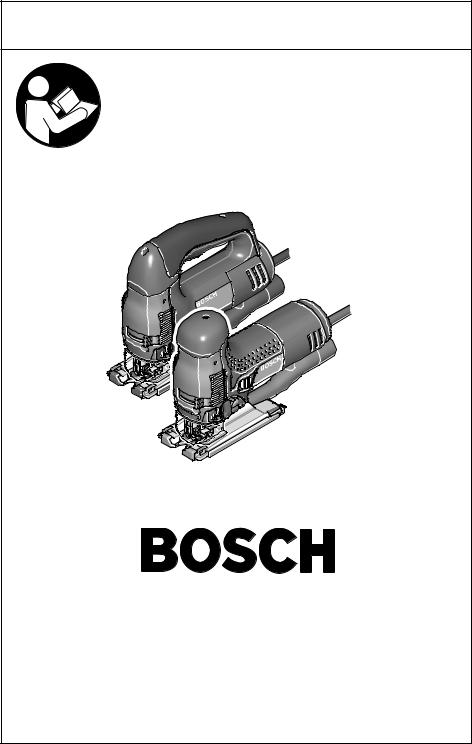
IMPORTANT: |
IMPORTANT : |
IMPORTANTE: |
Read Before Using |
Lire avant usage |
Leer antes de usar |
Operating/Safety Instructions
Consignes de fonctionnement/sécurité
Instrucciones de funcionamiento y seguridad
1590EVS
1591EVS
Consumer Information
Renseignement des consommateurs
Información para el consumidor
Toll Free Number: |
Appel gratuit : |
Número de teléfono gratuito: |
1-877-BOSCH99 (1-877-267-2499) http://www.boschtools.com |
||
|
|
|
For English |
Parlez-vous français? |
¿Habla español? |
See page 2 |
Voir page 13 |
Ver página 24 |

|
|
Power Tool Safety Rules |
|
|
Read and understand all instructions. Failure to follow all instructions |
|
! WARNING |
|
|
|
listed below, may result in electric shock, fire and/or serious personal injury. |
|
|
|
|
|
SAVE THESE INSTRUCTIONS |
Work Area
Keep your work area clean and well lit.
Cluttered benches and dark areas invite accidents.
Do not operate power tools in explosive atmospheres, such as in the presence of flammable liquids, gases, or dust. Power tools create sparks which may ignite the dust or fumes.
Keep by-standers, children, and visitors away while operating a power tool.
Distractions can cause you to lose control.
Electrical Safety
Double Insulated tools are equipped with a polarized plug (one blade is wider than the other.) This plug will fit in a polarized outlet only one way. If the plug does not fit fully in the outlet, reverse the plug. If it still does not fit, contact a qualified electrician to install a polarized outlet. Do not change the plug in any way. Double Insulation



 eliminates the need for the three wire grounded power cord and grounded power supply system. Before plugging in the tool, be certain the outlet voltage supplied is within the voltage marked on the nameplate. Do not use “AC only” rated tools with a DC power supply.
eliminates the need for the three wire grounded power cord and grounded power supply system. Before plugging in the tool, be certain the outlet voltage supplied is within the voltage marked on the nameplate. Do not use “AC only” rated tools with a DC power supply.
Avoid body contact with grounded surfaces such as pipes, radiators, ranges and refrigerators. There is an increased risk of electric shock if your body is grounded. If operating the power tool in damp locations is unavoidable, a Ground Fault Circuit Interrupter must be used to supply the power to your tool. Electrician’s rubber gloves and footwear will further enhance your personal safety.
Don't expose power tools to rain or wet conditions. Water entering a power tool will increase the risk of electric shock.
Do not abuse the cord. Never use the cord to carry the tools or pull the plug from an outlet. Keep cord away from heat, oil, sharp edges or moving parts. Replace damaged cords immediately. Damaged cords increase the risk of electric shock.
When operating a power tool outside, use an outdoor extension cord marked "W-A" or "W." These cords are rated for outdoor use and reduce the risk of electric shock. Refer to “Recommended sizes of Extension Cords” in the Accessory section of this manual.
Personal Safety
Stay alert, watch what you are doing and use common sense when operating a power tool. Do not use tool while tired or under the influence of drugs, alcohol, or medication. A moment of inattention while operating power tools may result in serious personal injury.
Dress properly. Do not wear loose clothing or jewelry. Contain long hair. Keep your hair, clothing, and gloves away from moving parts. Loose clothes, jewelry, or long hair can be caught in moving parts. Keep handles dry, clean and free from oil and grease.
Avoid accidental starting. Be sure switch is “OFF” before plugging in. Carrying tools with your finger on the switch or plugging in tools that have the switch “ON” invites accidents.
Remove adjusting keys or wrenches before turning the tool “ON”. A wrench or a key that is left attached to a rotating part of the tool may result in personal injury.
Do not overreach. Keep proper footing and balance at all times. Proper footing and balance enables better control of the tool in unexpected situations.
Use safety equipment. Always wear eye protection. Dust mask, non-skid safety shoes, hard hat, or hearing protection must be used for appropriate conditions.
Tool Use and Care
Use clamps or other practical way to secure and support the workpiece to a stable platform. Holding the work by hand or against your body is unstable and may lead to loss of control.
-2-

Do not force tool. Use the correct tool for your application. The correct tool will do the job better and safer at the rate for which it is designed.
Do not use tool if switch does not turn it “ON” or “OFF”. Any tool that cannot be controlled with the switch is dangerous and must be repaired.
Disconnect the plug from the power source before making any adjustments, changing accessories, or storing the tool. Such preventive safety measures reduce the risk of starting the tool accidentally.
Store idle tools out of reach of children and other untrained persons. Tools are dangerous in the hands of untrained users.
Maintain tools with care. Keep cutting tools sharp and clean. Properly maintained tools, with sharp cutting edges are less likely to bind and are easier to control. Any alteration or modification is a misuse and may result in a dangerous condition.
Check for misalignment or binding of moving parts, breakage of parts, and any other condition that may affect the tools
operation. If damaged, have the tool serviced before using. Many accidents are caused by poorly maintained tools. Develop a periodic maintenance schedule for your tool.
Use only accessories that are recommended by the manufacturer for your model. Accessories that may be suitable for one tool, may become hazardous when used on another tool.
Service
Tool service must be performed only by qualified repair personnel. Service or maintenance performed by unqualified personnel could result in a risk of injury. For example: internal wires may be misplaced or pinched, safety guard return springs may be improperly mounted.
When servicing a tool, use only identical replacement parts. Follow instructions in the Maintenance section of this manual.
Use of unauthorized parts or failure to follow Maintenance Instructions may create a risk of electric shock or injury. Certain cleaning agents such as gasoline, carbon tetrachloride, ammonia, etc. may damage plastic parts.
Safety Rules for Jigsaws
Hold tool by insulated gripping surfaces when performing an operation where the cutting tool may contact hidden wiring or its own cord. Contact with a "live" wire will make exposed metal parts of the tool "live" and shock the operator. Do not drill, fasten or break into existing walls or other blind areas where electrical wiring may exist. If this situation is unavoidable, disconnect all fuses or circuit breakers feeding this worksite.
Never leave the trigger locked "ON". Before plugging the tool in, check that the trigger lock is "OFF". Accidental startups could cause injury.
Be aware of the location and setting of the switch "Lock-ON" button. If the switch is locked "ON" during the use, be ready for emergency situations to switch it "OFF", by first pulling the trigger then immediately releasing it without pressing the "Lock-ON" button.
Keep hands away from cutting area. Do not reach under the material being cut.
The proximity of the blade to your hand is hidden from your sight.
Keep hands from between the gear housing and saw blade holder. The reciprocating blade holder can pinch your fingers.
Do not use dull or damaged blades. Bent blade can break easily or cause kickback.
Before starting to cut, turn tool "ON" and allow the blade to come to full speed.
Tool can chatter or vibrate if blade speed is too slow at beginning of cut and possibly kickback.
Secure material before cutting. Never hold it in your hand or across legs. Small or thin material may flex or vibrate with the blade, causing loss of control.
Make certain all adjusting screws and the blade holder are tight before making a
-3-

cut. Loose adjusting screws and holders can cause the tool or blade to slip and loss of control may result.
When removing the blade from the tool avoid contact with skin and use proper protective gloves when grasping the blade or accessory. Accessories may be hot after prolonged use.
Some dust created by power sanding, sawing, grinding, drilling, and other construction
activities contains chemicals known to cause cancer, birth defects or other reproductive harm. Some examples of these chemicals are:
•Lead from lead-based paints,
•Crystalline silica from bricks and cement and other masonry products, and
•Arsenic and chromium from chemicallytreated lumber.
Your risk from these exposures varies, depending on how often you do this type of work. To reduce your exposure to these chemicals: work in a well ventilated area, and work with approved safety equipment, such as those dust masks that are specially designed to filter out microscopic particles.
-4-

Symbols
IMPORTANT: Some of the following symbols may be used on your tool. Please study them and learn their meaning. Proper interpretation of these symbols will allow you to operate the tool better and safer.
Symbol |
Name |
Designation/Explanation |
||||||||
|
|
|
|
|
|
|
|
|
|
|
|
|
|
|
V |
Volts |
Voltage (potential) |
||||
|
|
|
|
A |
Amperes |
Current |
||||
|
|
|
|
|
|
|
|
|
|
|
|
|
Hz |
Hertz |
Frequency (cycles per second) |
||||||
|
|
|
W |
Watt |
Power |
|||||
|
|
|
kg |
Kilograms |
Weight |
|||||
|
|
|
|
|
|
|
|
|
|
|
|
min |
Minutes |
Time |
|||||||
|
|
|
|
s |
Seconds |
Time |
||||
|
|
|
|
|
|
|
|
|
|
|
|
|
|
|
|
|
|
|
|
Diameter |
Size of drill bits, grinding wheels, etc. |
|
|
|
|
|
|
|
|
|
|
|
|
|
|
n0 |
No load speed |
Rotational speed, at no load |
|||||
.../min |
Revolutions or reciprocation per minute |
Revolutions, strokes, surface speed, |
||||||||
|
|
|
|
|
|
|
|
|
|
orbits etc. per minute |
0 |
|
|
|
Off position |
Zero speed, zero torque... |
|||||
|
|
|
|
|
|
|
|
|
|
|
1, 2, 3, ... |
Selector settings |
Speed, torque or position settings. |
||||||||
I, II, III, |
|
Higher number means greater speed |
||||||||
|
|
|
|
|
|
|
|
|
|
|
0 |
|
|
|
|
|
|
Infinitely variable selector with off |
Speed is increasing from 0 setting |
||
|
|
|
|
|
|
|
|
|
Arrow |
Action in the direction of arrow |
|
|
|
|
|
|
|
|
|
||
|
|
|
|
|
|
|
|
|
Alternating current |
Type or a characteristic of current |
|
|
|
|
|
|
|
|
|
|
|
|
|
|
|
|
|
|
|
|
Direct current |
Type or a characteristic of current |
|
|
|
|
|
|
|
|
|
||
|
|
|
|
|
|
|
|
|
Alternating or direct current |
Type or a characteristic of current |
|
|
|
|
|
|
|
|
|
||
|
|
|
|
|
|
|
|
|
|
|
|
|
|
|
|
|
|
|
|
Class II construction |
Designates Double Insulated |
|
|
|
|
|
|
|
|
|
||
|
|
|
|
|
|
|
|
|
|
Construction tools. |
|
|
|
|
|
|
|
|
|
|
|
|
|
|
|
|
|
|
|
|
|
|
|
|
|
|
|
|
|
|
|
Earthing terminal |
Grounding terminal |
|
|
|
|
|
|
|
|
|
||
|
|
|
|
|
|
|
|
|
Warning symbol |
Alerts user to warning messages |
|
|
|
|
|
|
|
|
|
||
|
|
|
|
|
|
|
|
|
||
|
|
|
|
|
|
|
|
|
Ni-Cad RBRC seal |
Designates Ni-Cad battery recycling |
|
|
|
|
|
|
|
|
|
|
program |
|
|
|
|
|
|
|
|
|
|
|
This symbol designates that this tool is listed by Underwriters Laboratories.
This symbol designates that this tool is listed by the Canadian Standards Association.
This symbol designates that this tool is listed to Canadian Standards by Underwriters Laboratories.
This symbol designates that this tool is listed by Underwriters Laboratories, and listed to Canadian Standards by Underwriters Laboratories.
This symbol designates that
this tool complies to NOM Mexican Standards.
-5-

Functional Description and Specifications
Disconnect the plug from the power source before making any assembly, adjustments or changing accessories. Such preventive safety
measures reduce the risk of starting the tool accidentally.
Jigsaws
|
FIG. 1 |
VARIABLE SPEED |
TRIGGER SWITCH |
|
CONTROL DIAL |
|
“LOCK-ON” BUTTON
(Model 1590EVS only)




 6
6 



BLADE |
|
EJECTOR |
|
LEVER |
|
|
VACUUM HOSE |
|
(Not included, |
|
available as |
|
accessory) |
|
INTAKE VENTILATION |
DUST |
OPENINGS |
|
|
SHROUD |
VACUUM HOSE ADAPTER |
(Not included, |
|
available as |
TUBE (Not included, |
accessory) |
available as accessory) |
|
DUST BLOWER LEVER |
NON-MARRING |
BLADE ORBIT |
OVERSHOE |
SELECTOR LEVER |
|
PRECISION |
|
CONTROL BUTTON |
BLADE |
|
|
|
FOOTPLATE |
|
|
|||
|
|
|
|
SLIDE ON-OFF SWITCH |
|
|
|
|
(Model 1591EVS only) |
Model number |
1590EVS & 1591EVS |
Voltage rating |
120 V 50 - 60Hz |
Amperage rating |
6.4 A |
No load speed |
n0 500-2,800/min |
Stroke length |
1" |
Wood |
5-3/8" |
Aluminium |
3/4" |
Steel |
3/8" |
Stainless steel |
1/8" |
-6-
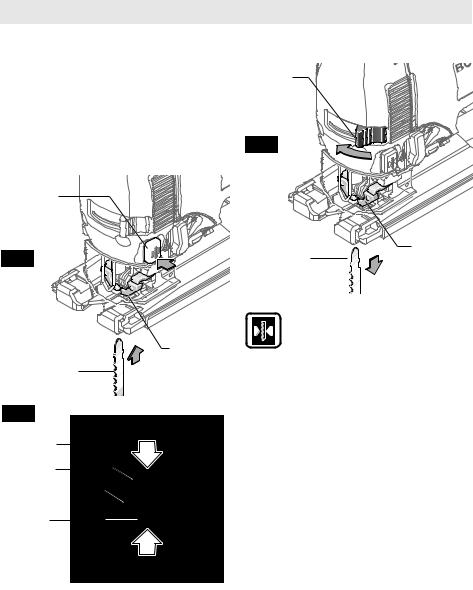
Assembly
BLADE INSTALLATION AND REMOVAL
This jigsaw is equipped with the Bosch “One Touch” tool-less blade changing system. This system makes changing blades simple and fast.
Insert the saw blade (teeth in cutting direction) until it latches in the plunger (Fig. 2.) When inserting the saw blade, the back of the blade must rest in the groove of the guide roller (Fig. 3).
PRECISION
CONTROL
BUTTON
FIG. 2
PRECISION
CONTROL
GUIDES
BLADE
FIG. 3
PLUNGER
PRECISION
CONTROL
GUIDES
GUIDE
ROLLER
Note: If the saw blade cannot be inserted into the plunger, the slots of the blade holder are not positioned as shown, or because the precision control guides are shut, push the blade ejector lever briefly to the front and release (Fig. 4).
To change the saw blade, push the ejector lever to the center stop; this releases the precision control guides and ejects the saw blade (Fig. 4).
When changing the blade, tool should be held so that the blade is safely ejected.
BLADE EJECTOR
LEVER
FIG. 4
|
PRECISION |
BLADE |
CONTROL |
GUIDES |
were cut
accuracy of |
saw blade. |
To use this feature simply press the precision control button to close the guides for precision control. The saw blade is now guided laterally by the precision control guides which enables precision cuts.
The precision control guides can be used for all applications, including bevel cuts. Precision control is recommended for cuts in thick wood, as the cutting angle is maintained and run-out of the saw blade is reduced. Refer to Operating Tips for more information.
DUST EXTRACTION
(Not included, available as accessory)
A vacuum hose adapter tube and dust shroud (optional accessory) can be attached for dust and chip extraction. The vacuum hose adapter tube serves as the connector to the vacuum hose.
ATTENTION: The vacuum hose adapter must only be used with dust shroud when connected to a vacuum.
To use this feature, attach vacuum hose adapter tube to footplate. When inserting the adapter tube into the footplate be sure that the plastic post of the adapter tube engages into the corresponding hole on the housing (Fig. 5).
-7-
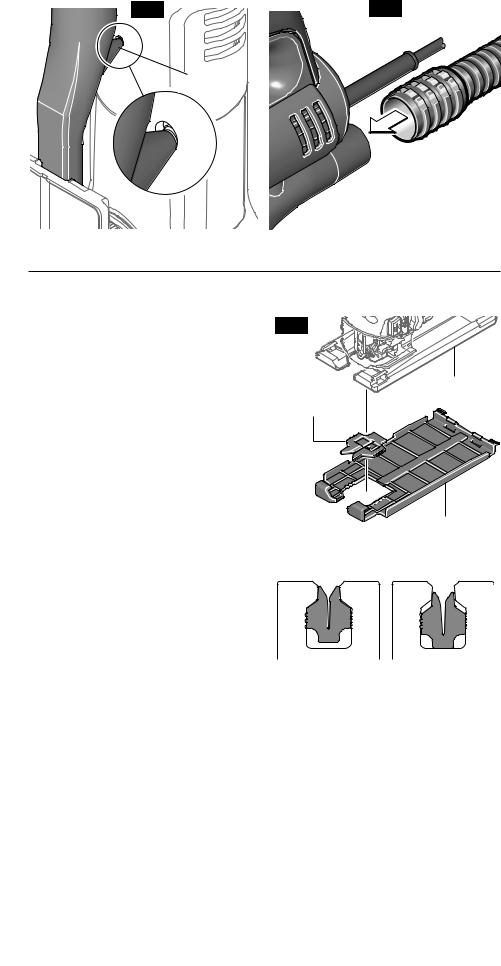
For vacuuming, a Bosch Air Sweep vacuum hose (optional accessory) can be directly connected to the vacuum hose adapter tube (Fig. 6).
FIG. 5
For maximum vacuum dust pick up, dust shroud must be attached.
FIG. 6
PLASTIC
POST
ATTACHING NON-MARRING OVERSHOE
Your tool is equipped with a protective plastic overshoe that protects finer surfaces.
To attach, hook overshoe over front of metal footplate and snap into place at rear of footplate (Fig. 7).
ANTI-SPLINTER INSERT
To minimize splintering of the top surface of the material being cut, place the anti-splinter insert in the blade opening of the footplate (Fig. 7).
The anti-splinter insert can be inserted into the footplate in two positions.
For narrow saw blades, place the insert completely to the front of the opening (Fig. 8).
For wider saw blades, place the insert completely to the rear of the opening (Fig. 9).
Note: This insert will only work with blades that have ground sides such as T301CD, T101B, T101D, and T101DP.
FIG. 7
FOOTPLATE
ANTI-SPLINTER
INSERT
NON-MARRING
OVERSHOE
FIG. 8 |
|
FIG. 9 |
-8-
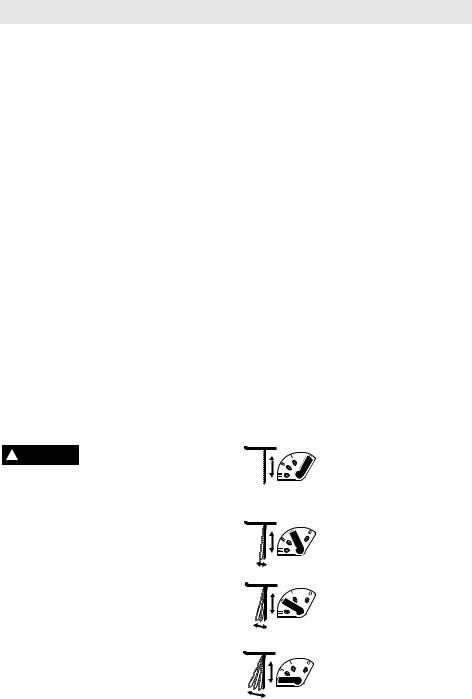
Operating Instructions
PLUNGER SPEED
The jigsaw cutting speed or stroke rate required depends on the material being cut, the type of blade being used, and the feed rate preferred by the operator.
The best speed for a particular application is largely determined by experience though as a general rule, slower speeds are for denser materials and faster speeds for softer materials.
Note that when the jigsaw is used at low speed settings for an extended length of time, the motor temperature will rise due to slower speeds of the internal cooling fan. In such cases, it is necessary to occasionally run the tool at full speed for a few minutes to keep the motor running at high efficiency.
TRIGGER SWITCH WITH "LOCK-ON" BUTTON (Model 1590EVS only)
Your jigsaw can be turned "ON" or "OFF" by squeezing or releasing the trigger. Your jigsaw is also equipped with a "Lock-ON" button located just above the trigger that allows continuous operation without holding the trigger (Fig. 1).
TO LOCK SWITCH ON: Squeeze trigger fully, depress button and release trigger.
TO UNLOCK THE SWITCH: Squeeze trigger and release it without depressing the "LockON" button.
If the "Lock-ON" button is continuously being de-
pressed, the trigger cannot be released.
SLIDE ON-OFF SWITCH (Model 1591EVS only)
The tool is switched “ON” by the switch button located at the side of the motor housing. The switch locks in the “ON” position, a convenience for continuous operation (Fig. 1).
TO TURN THE TOOL “ON” slide the switch button forward.
TO UNLOCK THE SWITCH, slide the switch button backward.
CONSTANT RESPONSE CIRCUITRY
The internal electronic feedback system provides a "soft start", which will reduce the stresses that occur from a high torque start. The system also maintains the selected speed under load for maximum efficiency.
VARIABLE SPEED DIAL
Your Jigsaw is equipped with a variable speed dial. The blade stroke rate may be adjusted during cutting operation by presetting the dial on or between any one of the six numbers.
Setting SPM rating (strokes per minute)
1500
2500-800
3500-1400
4500-1900
5500-2400
6500-2800
BLADE ORBIT SELECTOR LEVER
Maximum cutting efficiency can be obtained by adjusting the blade orbit selector lever to suit the material being cut.
The following chart will help you determine which setting to use for your application. This chart is intended as a guideline only, and test cuts in scrap material should be performed first to determine the best setting.
Setting O
Hard materials such as metals or thin sheet metals. This setting can be used with knife blades, grit edge blades, rasp work and down cutting blades.
Setting 1
Soft materials where cleaner cutting or delicate scrolling work is performed.
Setting 2
Medium density materials such as harder woods or particle board.
Setting 3
Soft materials such as wood, plastics, etc. and when fast cutting is more important than a clean cut.
-9-
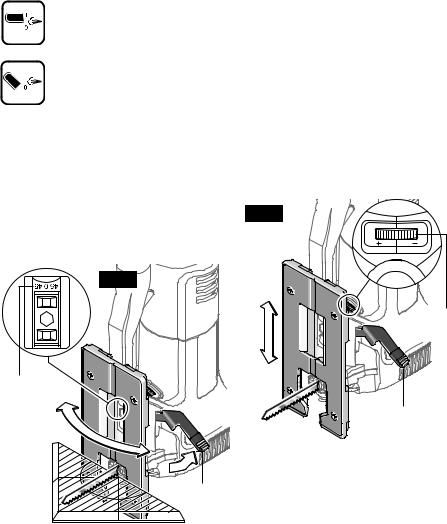
CHIP BLOWER
Your jigsaw is equipped with a two position chip blower to help keep the cutting line clear of chips.
By adjusting the chip blower lever the force of the discharge air may be altered as follows;
BLOWER SWITCHED ON
For working with wood, plastic and similar materials that produce large amounts of sawdust.
BLOWER SWITCHED OFF
For working with metals and when cooling agents are used, or with dust collection accessory.
FOOTPLATE ANGLE ADJUSTMENT
The footplate may be tilted to allow angle cuts up to 45º in either direction (Fig. 10).
To adjust footplate, remove dust shroud if used, open footplate lock lever and slide the footplate slightly forward towards the front of tool, then rotate to desired angle (Fig. 10).
Note: If the footplate cannot be adjusted or you have difficulty after the footplate lock lever has been released, rotate tension wheel in the “-” direction (Fig. 11).
FIG. 10
Note: If the lock lever does not securely tighten the footplate after the lever is closed, open lock lever and rotate the tension wheel in the “+” direction until desired tension has been achieved (Fig. 11).
FLUSH CUTTING
To allow the saw to make a perpendicular cut close to a vertical surface, the footplate may be repositioned as follows.
Note that when the footplate is retracted in this manner, only 90º cuts are possible, and the optional cutting guide and anti-splinter insert guide may not be used.
To adjust footplate, remove dust shroud and anti-splinter insert, open footplate lock lever move the footplate back in the 0º alignment slot (Fig. 11).
Note: If the footplate cannot be adjusted or you have difficulty after the footplate lock lever has been released, rotate tension wheel in the “-” direction (Fig.11).
FIG. 11
BEVEL
SCALE
FOOTPLATE |
LOCK LEVER |
The detent slots will hold the footplate firmly at 45º, and there are additional position marks for 15º, 22.5º and 30º angles. Intermediate angles may be set with a protractor (Fig. 10).
After positioning the footplate close the footplate lock lever to securely tighten the footplate adjustment (Fig. 10).
TENSION
WHEEL
FOOTPLATE
LOCK LEVER
After positioning the footplate close the footplate lock lever to securely tighten the footplate adjustment (Fig. 11).
Note: If the lock lever does not securely tighten the footplate after the lever is closed, open lock lever and rotate the tension wheel in the “+” direction until desired tension has been achieved (Fig. 11).
TOOL TIPS
Always be certain that smaller workpieces are securely fastened to a bench or other support. Larger panels may be held in place by clamps on a bench or sawhorses.
-10-
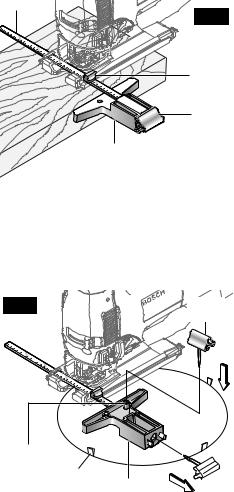
To begin a cut, clearly mark the cutting line, and rest the front of the footplate on the work. Engage the switch, and move the blade into the work using only enough forward pressure to keep the blade cutting steadily. Do not force, as this will not make the saw cut faster; let the blade do the work.
Choose blades carefully, as the ability of the jigsaw to follow curves, provide smoother finishes, or faster cutting is directly related to the type of blade used (See your Bosch Dealer).
For tight curves it is best to use a narrow or scroll blade.
When sawing metal or similar materials, shut off chip blower and apply coolant/lubricant alongside the cutting line.
When cutting thick wood, use the precision control button for increased lateral guidance of the saw blade.
PLUNGE CUTTING
Plunge cutting is useful and time-saving in making rough openings in softer materials. It is not necessary to drill a hole for an inside or pocket cut. Draw lines for the opening, hold the saw firmly, tilt it forward so that the toe of the saw foot rests on the work, but with the blade well clear of the work. Start the motor, and then very gradually lower the blade. When it touches, continue pressing down on the toe of the saw foot slowly pivoting the saw like a hinge until the blade cuts through and the foot rests flat on the work. Then saw ahead on the cutting line. We do not recommend plunge cutting with a scroll blade.
To make sharp corners, cut up to the corner, then back up slightly before rounding the corner. After the opening is complete, go back to each corner and cut it from the opposite direction to square it off. Do not try to plunge cut into hard materials such as steel.
CIRCLE AND PARALLEL CUTTING GUIDE (Not included, available as accessory)
This accessory is available at an extra cost. It is used for fast and accurate straight and circle cutting (Fig.12).
PARALLEL CUTTING
1.Insert bar of guide through lock knob clamp, then through the slots provided in foot, from either side of foot with the edge guide facing DOWN (Fig. 12).
2.Hook lock knob clamp onto edge of footplate, adjust fence to desired width, and securely tighten lock knob clamp (Fig. 12).
BAR
FIG. 12
LOCK
KNOB
CLAMP
GUIDE
PIN
EDGE GUIDE DOWN
CIRCLE CUTTING
1.Before attaching the guide, draw a circle and predrill a 13/64” center hole in workpiece.
2.Drill or plunge cut near the circles edge, turn saw off and disconnect the plug from power source.
3.Attach guide to saw with edge guide facing UP as shown (Fig. 13).
FIG. 13 |
GUIDE |
|
PIN |
2
GUIDE |
|
PIN |
1 |
HOLE WEDGE |
|
|
EDGE |
|
GUIDE UP |
4.Remove guide pin from end of guide, push pin through hole provided in guide, then into center hole of workpiece.
5.Measure the distance from the selected hole to the blade to be equal to the circle radius.
6.Insert plug into power source, hold the saw firmly, squeeze trigger and slowly push the saw forward. To make a hole, cut from inside the circle; To make wheels or discs, cut from the outside.
Cutting Tip: Cut slowly so the blade will stay straight in the cut. Place small wedges in the cut as shown in Fig. 13, to keep the inner circle from spreading when near the end of the cut.
-11-
